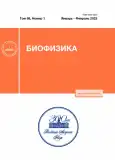Induction of damage to the dna structure of tumor cells by aurum polyacrylate
- Авторлар: Chigasova A.K1, Ostrovskaya L.A1, Korman D.B1
-
Мекемелер:
- Emanuel Institute of Biochemical Physics, Russian Academy of Sciences
- Шығарылым: Том 68, № 1 (2023)
- Беттер: 11-19
- Бөлім: Articles
- URL: https://journals.rcsi.science/0006-3029/article/view/144400
- DOI: https://doi.org/10.31857/S0006302923010027
- EDN: https://elibrary.ru/NYQIWK
- ID: 144400
Дәйексөз келтіру
Толық мәтін
Аннотация
Авторлар туралы
A. Chigasova
Emanuel Institute of Biochemical Physics, Russian Academy of SciencesMoscow, Russia
L. Ostrovskaya
Emanuel Institute of Biochemical Physics, Russian Academy of Sciences
Email: larros@list.ru
Moscow, Russia
D. Korman
Emanuel Institute of Biochemical Physics, Russian Academy of SciencesMoscow, Russia
Әдебиет тізімі
- Д. Б. Корман, Л. А. Островская, Н. В. Блюхтерова и др., Биофизика, 66 (6), 1229 (2021). doi: 10.31857/S000630292106020X
- Д. Б. Корман, Л. А. Островская и В. А. Кузьмин, Вопр. онкологии, 64 (6) 697 (2018).
- Л. А. Островская, Д. Б. Корман, Н. В. Блюхтерова и др., Хим. физика, 38 (12), 64 (2019).
- Л. А. Островская, Д. Б. Корман, Н. В. Блюхтерова и др., Росс. биотерапевтич. журн., 19 (4), 74 (2020).
- Л. А. Островская, Д. Б. Корман, Е. И. Некрасова и др., Биофизика, 66 (5), 978 (2021). doi: 10.31857/S0006302921050161
- Л. А. Островская, Д. Б. Корман, Е. И. Некрасова и др., Биофизика, 67 (1), 82 (2022). doi: 10.31857/S0006302922010070
- Д. Б. Корман. Мишени и механизмы действия противоопухолевых препаратов (Практическая медицина, М., 2014).
- Л. А. Островская, Д. Б. Корман, А. К. Грехова и др., Биофизика, 62 (3), 598 (2017). doi: 10.1134/S0006350917030150
- Д. Б. Корман, Л. А. Островская и В. А. Кузьмин, Биофизика, 64 (3), 552 (2019). doi: 10.1134/S0006350919030102
- L. Messori, P. Orioli, C. Tempi, et al., Biochem. Biophys. Res.Commun., 221, 852 (2001). doi: 10.1006/bbrc.2001.4348
- P. Shi, Q. Jiceng, Y. Zhao, et al., J. Biol. Inorg. Chem., 11, 745 (2006). doi: 10.1007/s00755-006-0120-y
- M. S. Alsaeedi, B. A. Babgi, M. A. Hussein, et al., Molecules, 25, 1933 (2020). doi: 10.3390/j.molecules 25051033
- B. Possato, L. R. Dalmolin, L. M. Pereira, et al., Eur. J. Pharm. Sci., 162, 105834 (2021). doi: 10.1016/j.ejps.2021.105834
- C. K. Mirabelli, J. B. Zimmerman, H. R. Bartus, et al., Biochem. Pharmacol., 35, 1435 (1986). doi: 10.1016/0006-2952(86)90107-3
- S. Bestgen, C. Seide, T. Wiesher, et al., Chemistry, 23, 6315 (2017). doi: 10.1002/chem.201605337
Қосымша файлдар









